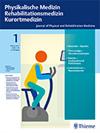手法治疗外侧上髁炎疗效的随机对照试验
IF 0.5
4区 医学
Q4 REHABILITATION
Physikalische Medizin Rehabilitationsmedizin Kurortmedizin
Pub Date : 2022-05-11
DOI:10.1055/a-1870-3073
引用次数: 0
摘要
摘要背景肱骨桡侧上髁病通常由全科医生诊断。通常,治疗包括使用前臂支架经皮神经电刺激。在经皮电神经刺激和前臂支架使用之前,由专门的物理治疗师进行手工治疗。然而,比较所有方法有效性的研究很少。目的比较手法治疗、经皮神经电刺激和前臂支架的治疗效果,以及三者联合治疗的效果。方法将52例确诊为肱骨桡上髁病的患者随机分为三个治疗组:手工治疗、经皮神经刺激和前臂支架联合使用(n=19);仅手工治疗(n=18);前臂支架联合经皮神经刺激(n=15)。除手工治疗外,所有测量和治疗均在第一作者的执业场所进行。主要结局包括活动范围和疼痛强度;次要结果是肘部功能和心理健康。主要和次要结果分别在治疗前和治疗后4周和8周使用患者评定网球肘评估问卷和简短健康调查问卷进行测量。结果两组患者的活动范围和疼痛强度无明显差异。结论单纯手疗与经皮神经刺激联合前臂支具治疗肱骨上髁突病疗效相当。我们的研究结果支持将手工疗法作为治疗肱骨桡侧上髁性病变的独立治疗方案纳入指南。本文章由计算机程序翻译,如有差异,请以英文原文为准。
Therapeutic Effects of Manual Therapy on Lateral Epicondylitis: A Randomised Controlled Trial
Abstract Background Epicondylopathia humeri radialis is often diagnosed by general practitioners. Usually, the therapy comprises transcutaneous electrical nerve stimulation using a forearm brace. Manual therapy, performed by specialised physiotherapists, is prescribed before transcutaneous electrical nerve stimulation and forearm brace use. However, studies comparing the effectiveness of all methods are scarce. Objective To compare the therapeutic effects of manual therapy, transcutaneous electrical nerve stimulation, and forearm brace use, as well as the combination of all three. Methods Fifty-two patients diagnosed with epicondylopathia humeri radialis were randomised into three treatment arms: a combination of manual therapy, transcutaneous nerve stimulation, and forearm brace use (n=19); manual therapy only (n=18); and a combination of forearm brace use and transcutaneous nerve stimulation (n=15). All measurements and therapies, excluding manual therapy, were performed at the first author’s practice premises. The primary outcomes included range of motion and pain intensity; the secondary outcomes were elbow function and psychological well-being. Primary and secondary outcomes were measured before and at 4 and 8 weeks after treatment using the Patient Rated Tennis Elbow Evaluation Questionnaire and the Short Form Health Survey Questionnaire. Results The range of motion and pain intensity did not differ among the groups. Conclusion Manual therapy alone was as effective as the combination of transcutaneous nerve stimulation and forearm brace use for epicondylopathia humeri radialis. Our findings support the inclusion of manual therapy as a stand-alone therapy option in the guidelines for treating patients with epicondylopathia humeri radialis.
求助全文
通过发布文献求助,成功后即可免费获取论文全文。
去求助
来源期刊
CiteScore
1.10
自引率
25.00%
发文量
70
审稿时长
3 months
期刊介绍:
The Journal of Physical and Rehabilitation Medicine offers you the most up-to-date information about physical medicine in clinic and practice, as well as interdisciplinary information about rehabilitation medicine and spa medicine.
Publishing 6 issues a year, the journal includes selected original research articles and reviews as well as guidelines and summaries of the latest research findings. The journal also publishes society news and editorial material. “Online first” publication ensures rapid dissemination of knowledge.

 求助内容:
求助内容: 应助结果提醒方式:
应助结果提醒方式:


